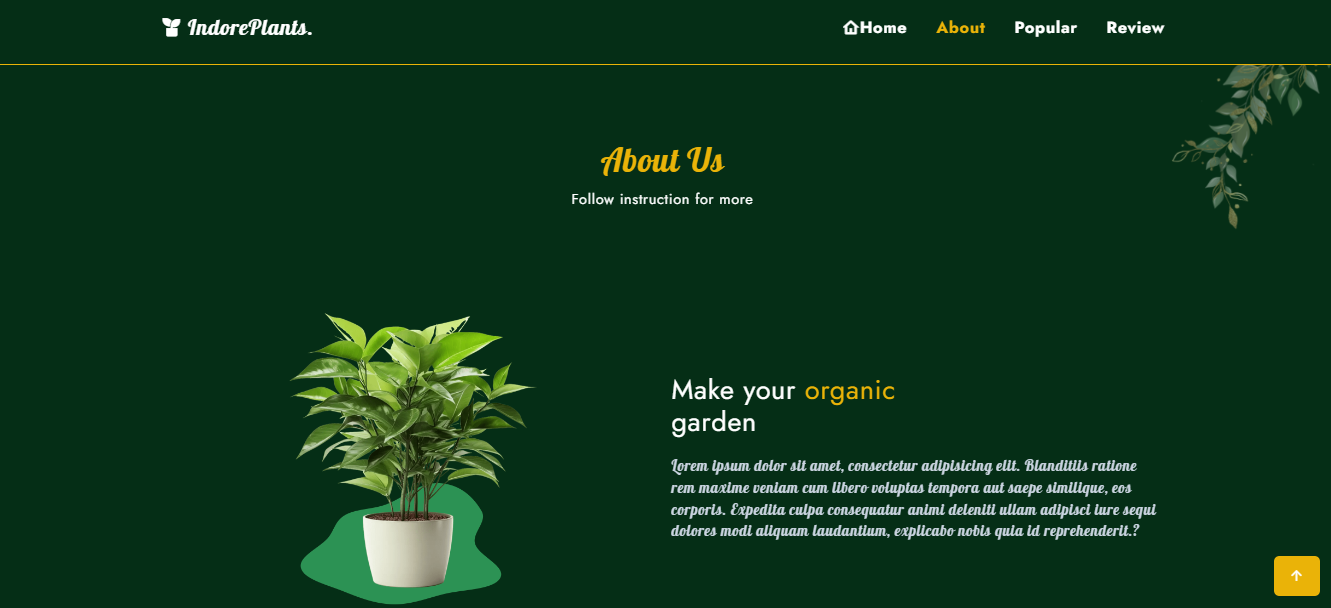A plant website could feature detailed information on various plant species, including care guides, growth habits, and ideal conditions. It might offer a plant identification tool, a blog with gardening tips, an online store for seeds and tools, and a community forum for plant enthusiasts. The design would likely be lush and green, with vibrant images and user-friendly navigation to make learning about and purchasing plants easy and enjoyable.
You can see the live demo project please Click Here
- Gardening Blog: Regularly updated articles on topics like gardening tips, seasonal advice, and plant care.
- Fluid Grid Layout: Uses a flexible grid that resizes and repositions elements dynamically to fit the screen size, from desktops to mobile devices.
- Responsive Navigation Menu: A navigation menu that adapts to different screen sizes, often transforming into a collapsible or “hamburger” menu on smaller screens.
- Mobile-First Design: Designed with mobile users in mind first, ensuring that essential features and content are easily accessible on smaller screens.
- HTML5/TailwindCSS v3.4.10 : Structure and styling of the website.
- JavaScript : Interactive features and dynamic content.
- Responsive Design : Customizing Screens, Flexbox, and Grid for mobile-friendly design
- ScrollReveal : This is a JavaScript library that allows you to easily create and manage scroll-based animations on a website.
- Remix Icon : This is a set of open-source, high-quality icons designed for web development.
- Swiper CSS v11.1.10 : Swiper is a modern, flexible, and highly customizable touch slider that you can use for implementing sliders, carousels, and other interactive content on your website.
- Node.js : JavaScript runtime for server-side development.
- Git : Distributed version control system.
- Netlify/Vercel : Hosting platforms for static websites and JAMstack applications.
- Code Editor : You can use any code editor like Visual Studio Code, Sublime Text, or others to write your code.
- Node.js : Tailwind CSS requires Node.js to run. You can download it from the official Node.js website.
- npm (Node Package Manager) : npm comes bundled with Node.js. You'll use npm to install Tailwind CSS and other dependencies.
If you run this project locally, then follow these steps below :
-
Open Terminal (Command Prompt, PowerShell, etc.) :
-
Navigate to the directory where you want to clone the project.
-
Run the following command to clone the repository:
https://github.com/pranto113015/Plants-Website-Using-tailwindCss.git
-
-
Navigate into the project directory :
-
Replace
Plants-Website-Using-tailwindCsswith the actual folder name of the project.cd Plants-Website-Using-tailwindCss
-
-
Run Tailwind CSS in Watch Mode :
-
To start watching for changes, run:
npm run watch
-
-
Click the run option of the menu bar and again click the start debugging or open with live server
Or you can do this way
-
Download the project
-
Unzip the file
-
Open with your IDE such as vs code and follow the command :
npm run watch
-
Now open with live server
- Collection of plant information
- Gardening Guide
- Plant identification and identification
- Research and educational materials
- Collect feedback and suggestions
- Tailwind CSS uses a utility-first approach, meaning you apply classes like bg-blue-500 directly to HTML elements.
- You can customize Tailwind CSS by modifying the tailwind.config.js file.
- Tailwind CSS often works well with component-based frameworks like Vue, React, or Angular, as it provides a flexible way to style reusable UI elements.
Contributions are what make the open-source community such an amazing place to be, learn, inspire, and create. Any contributions you make are greatly appreciated.Here are some ways you can get started:
- Report bugs : If you encounter any bugs, please let us know. Open up an issue and let us know the problem.
- Contribute code : If you are a developer and want to contribute, follow the instructions below to get started.
- Suggestions : If you don't want to code but have some awesome ideas, open up an issue explaining some updates or imporvements you would like to see.
- Documentation : If you see the need for some additional documentation, feel free to add some.
-
Fork the Project
-
Create your Feature Branch
$ git checkout -b feature/AmazingFeature
-
Commit your Changes
git commit -m 'Add some AmazingFeature' -
Push to the Branch
git push origin feature/AmazingFeature
-
Open a Pull Request
State the license under which your project is distributed. This project is licensed under the MIT License - see the LICENSE file for details.
This project created for amazing features tailwind css practise.
If you have any questions or need further clarification, please contact my email/ Linkedin .
-
💌 Email : pranto113015@gmail.com
-
🕵️♂️ Linkedin : Pranto Kumar
Thank you for reviewing my project 💙



